Navigating Volatility in Precious Metals Trading: Risks, Signals, and Strategies (Part Two)
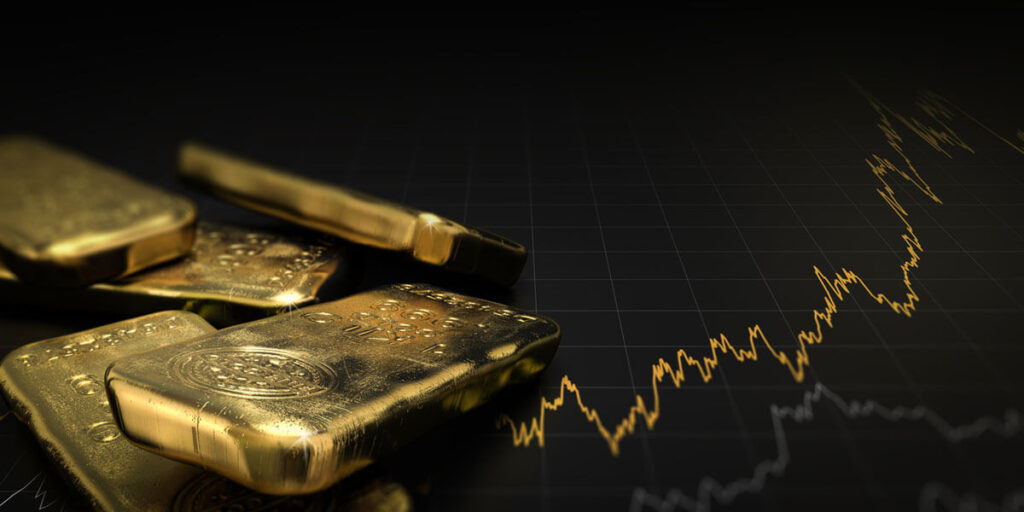
Building upon the foundation laid in Part One of our guide, where we explored the risks, signals, and essential strategies for navigating volatility in precious metals trading, we now embark on a deeper journey into the world of trading these coveted commodities. In Part Two, we’ll equip you with actionable insights on how to potentially capitalize on news events, harness the power of technical indicators, and implement common trading strategies. With a keen focus on gold, silver, and platinum, as well as base metals like zinc, nickel, and palladium, we’ll delve into specific approaches tailored to each metal. By combining these insights with the knowledge gained in Part One, you’ll be poised to navigate the dynamic landscape of precious metals trading with more confidence.
Trading Volatility in the Precious Metals Sector
1. Take Advantage of News Events
- Capitalize on major news events and economic releases that tend to cause volatility in precious metals markets. Be prepared to act swiftly and have a clear plan in place. Being proactive in responding to significant news events is a key strategy in precious metals trading. By understanding how news can impact prices, traders can position themselves to potentially capitalize on possible market movements. Here’s how you can approach this strategy for each of the metals:
Gold
- Geopolitical Events: Gold is often considered a safe-haven asset, and its price can surge during times of geopolitical uncertainty. Monitor events such as political instability, or major policy shifts. Look for news related to international relations, elections, and major policy decisions.
- Central Bank Announcements: Pay close attention to statements and decisions from major central banks, particularly those related to interest rates, monetary policy, and quantitative easing. Changes in central bank policies can significantly influence gold prices.
Silver
- Industrial Demand: Silver has industrial applications in addition to its role as a precious metal. Monitor manufacturing data, technological advancements, and trends in industries like electronics and renewable energy. News related to advancements in solar technology, electronics manufacturing, and green energy initiatives can impact silver prices.
- Mining and Supply Reports: Keep track of reports related to silver mining production and supply. Disruptions in mining operations or changes in production levels can lead to rapid price movements.
Platinum
- Automotive Industry Trends: Platinum is heavily used in the automotive industry, particularly in catalytic converters. Stay updated on global car sales trends, emission regulations, and shifts towards electric vehicles. News related to advancements in automotive technology and emission standards can influence platinum prices.
- Supply from Major Producers: Pay attention to reports on platinum production and supply from major producing countries like South Africa and Russia. Supply disruptions or changes in production levels can have a significant impact on platinum prices.
Zinc, Nickel, and Palladium
- Manufacturing Data: For base metals like Zinc and Nickel, as well as Palladium, news related to manufacturing data and industrial activity is crucial. Monitor reports on manufacturing output, infrastructure projects, and trends in industries that heavily rely on these metals.
- Automotive Industry Trends (especially for Palladium): Like platinum, Palladium is used in the automotive industry. Stay informed about trends in car sales, emission standards, and the adoption of electric vehicles. News related to developments in the automotive sector can impact Palladium prices.
Utilize Technical Indicators
When volatility is high, technical indicators can be particularly useful. Look for instances where multiple indicators align to confirm potential entry or exit points. Employing a mix of classic and newly discovered technical indicators from platforms like TradingView can potentially enhance your trading decisions. When these indicators align, it can strengthen the conviction in a potential trade.
Here’s how you can apply this for each of the metals:
Gold
- Example: You’re considering a long position in gold. You notice that the Relative Strength Index (RSI) has dipped below 30, indicating potential oversold conditions which acts as a signal. Simultaneously, the Ichimoku Cloud indicator shows a bullish Tenkan-Kijun crossover, suggesting a potential trend reversal and confirming the RSI signal This alignment (oversold RSI and Ichimoku Cloud crossover) may signal a potential entry point.
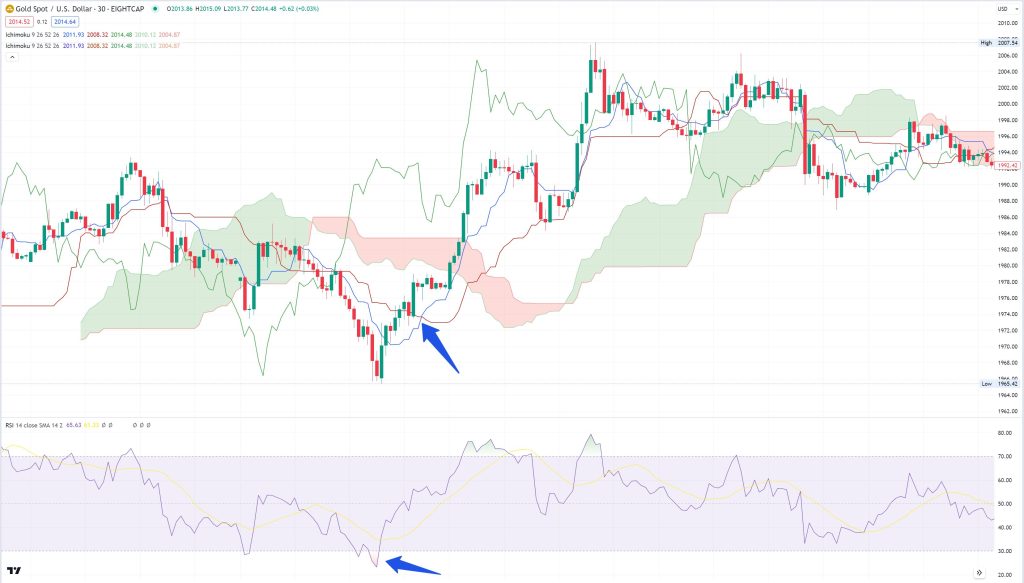
Silver
- Example: Suppose you’re evaluating a short position in silver. You observe that the Moving Average Convergence Divergence (MACD) has a bearish crossover, indicating potential downward momentum. Additionally, the Chande Momentum Oscillator (CMO) is in negative territory, providing confirmation of bearish sentiment. This alignment (bearish MACD and negative CMO) may signal a potential entry point.
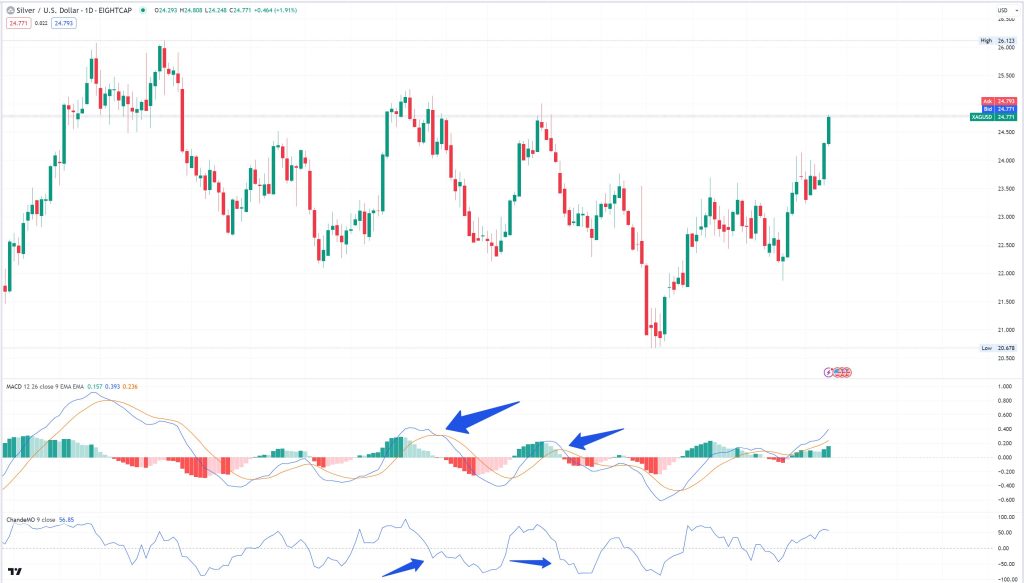
Platinum
- Example: Let’s say you’re looking to exit a long position in platinum. You notice that the Stochastic is in overbought territory, suggesting a potential reversal. Simultaneously, the Volume Weighted Moving Average (VWMA) is showing divergence from the price, indicating a potential shift in momentum. This alignment (overbought Stochastic and VWMA divergence) may signal a potential exit point.
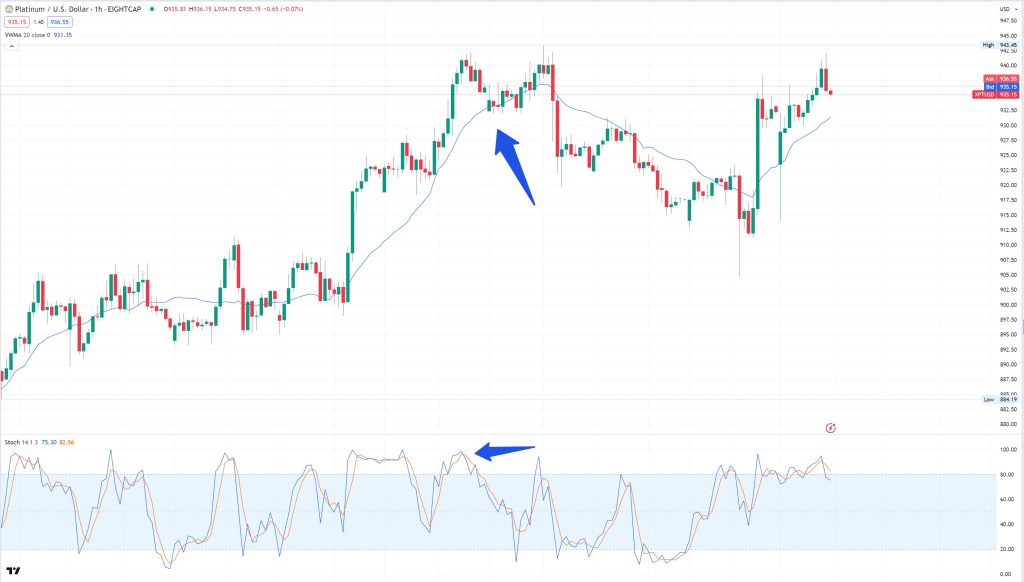
Zinc, Nickel, and Palladium
- Example: For base metals like Zinc and Nickel, as well as Palladium, a combination of classic and innovative indicators can be applied. Suppose you’re considering a long position in Nickel. You notice that the Money Flow Index (MFI) is showing strong positive divergence, indicating potential upward momentum. Simultaneously, the Relative Strength Index (RSI) confirms the bullish sentiment. This alignment (positive MFI divergence and bullish RSI) may signal a potential entry point.
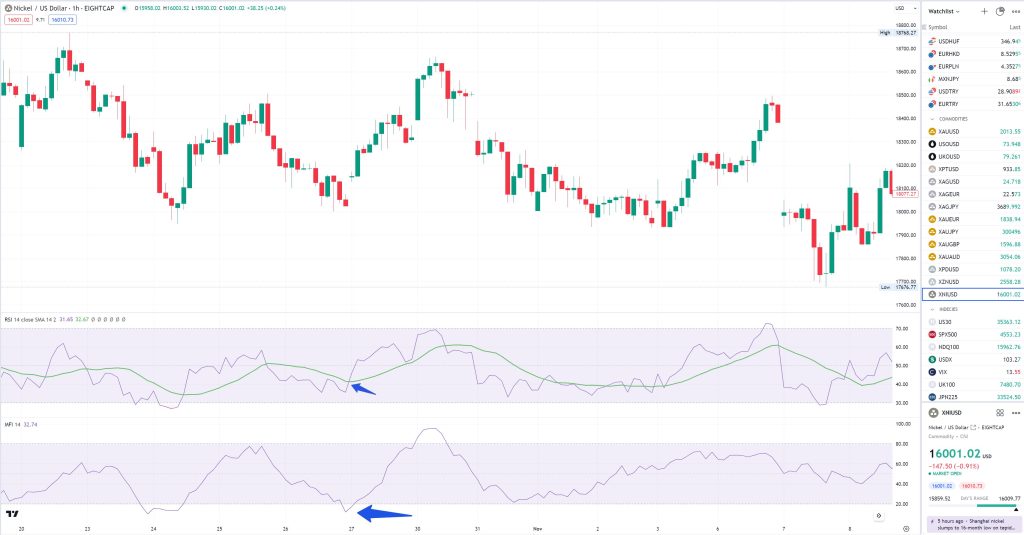
Strategies for Trading Precious Metals in Times of High Volatility
Navigating the precious metals market during periods of elevated volatility requires a well-defined trading strategy. Here are several effective approaches traders can consider:
Range Trading:
- Description: Range trading involves identifying key levels of support and resistance and executing trades within that range. Traders aim to profit from the price bouncing between established boundaries.
- Application: In times of high volatility, precious metals may exhibit significant price swings. Range traders can identify levels where prices are likely to find support or resistance and execute buy orders near support and sell orders near resistance.
Breakout Trading:
- Description: Breakout trading entails identifying significant support and resistance levels and entering trades when the price breaks out of these levels. This strategy aims to capitalize on substantial price movements following a period of consolidation.
- Application: During times of high volatility, precious metals may experience sharp price movements. Traders can look for breakouts above resistance levels for potential long trades or below support levels for potential short trades.
Trend Following:
- Description: Trend following is a strategy that aims to profit from established price trends. Traders identify the direction of the prevailing trend (up or down) and enter trades in the direction of that trend.
- Application: In periods of high volatility, trends may develop and persist. Traders can use technical indicators like Moving Averages, MACD, or trendlines to confirm and follow established trends.
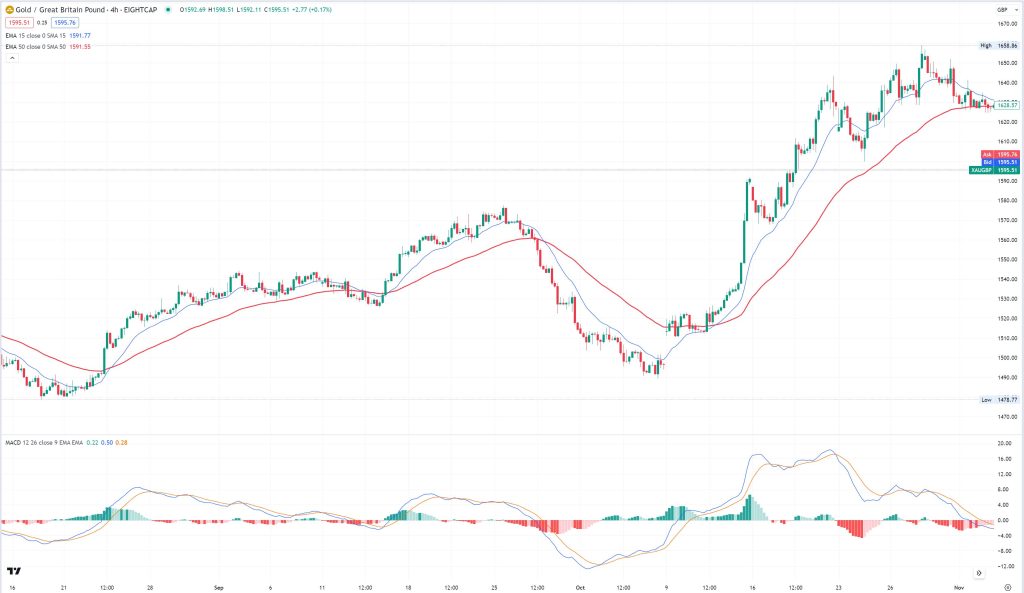
News Trading:
- Description: News trading involves making trading decisions based on the immediate impact of significant news events. Traders aim to anticipate how news releases will affect prices and position themselves accordingly.
- Application: During times of high volatility, news events can lead to rapid price movements. Traders can use economic calendars and news feeds to stay updated on upcoming announcements and react swiftly to market-moving news.
Mean Reversion:
- Description: Mean reversion strategies assume that prices will eventually return to their historical averages. Traders look for situations where prices have deviated significantly from their mean and anticipate a reversal.
- Application: In periods of high volatility, prices may overshoot their historical averages. Traders can use technical indicators like Bollinger Bands or RSI to identify overbought or oversold conditions and anticipate a reversion to the mean.
Selecting the most appropriate approach depends on factors such as risk tolerance, trading style, and market outlook. It’s crucial to employ proper risk management techniques and consider other factors like market news and economic events in conjunction with your chosen strategy. Remember, no strategy is foolproof, and flexibility in adapting to changing market conditions is an important factor in successful trading.
As we conclude Part Two of our comprehensive guide on Navigating Volatility in Precious Metals Trading, you’ve gained a wealth of actionable strategies and insights to potentially enhance your trading endeavors. From seizing opportunities presented by news events to leveraging the power of technical indicators, you now have a robust toolkit at your disposal. We’ve explored the intricacies of trading gold, silver, platinum, zinc, nickel, and palladium, providing possible approaches for each. By combining the knowledge and strategies presented in both Part One and Part Two, you’re well-equipped to navigate the dynamic and ever-evolving landscape of precious metals trading.
* The information provided here has been prepared by Eightcap’s team of analysts. All expressions of opinion are subject to change without notice. Any opinions made may be personal to the author and do not reflect the opinions of Eightcap.
In addition to the disclaimer on our website, the material on this page does not contain a record of our trading prices, or represent an offer or solicitation for a transaction in any financial instrument. Eightcap accepts no responsibility for any use that may be made of these comments and for any consequences that result. No representation or warranty is given as to the accuracy or completeness of this information. Consequently, any person acting on it does so entirely at their own risk. Any research provided does not have regard to the specific investment objectives, financial situation and needs of any specific person who may receive it. It has not been prepared in accordance with legal requirements designed to promote the independence of investment research and as such is considered to be a marketing communication.
Please note that past performance is not a guarantee or prediction of future performance. This communication must not be reproduced or further distributed without prior permission.


